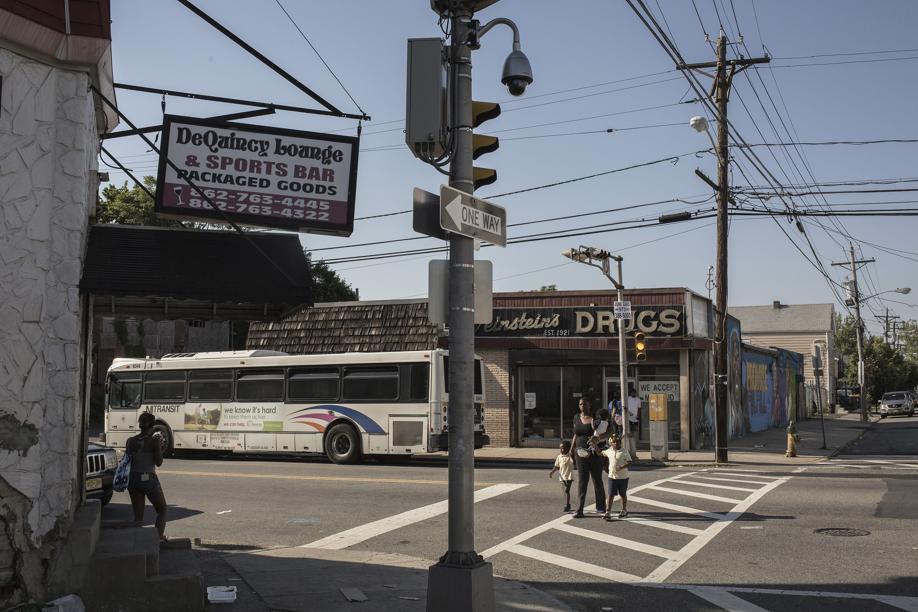
NEWARK — The camera perched above the bus stop sends back a continuous feed from the corner of 16th Avenue and South 18th Street in Newark’s West Ward.
Regular customers come and go from Max’s, a convenience store, and anyone with a fast internet connection and a desire to watch could also see Fernando Demarzino stepping out of his cousin’s barbershop.
“My girlfriend called and told me what I had in my hand,’’ Demarzino said on a recent evening as he stood within the camera’s line of sight.
His girlfriend had heard about official camera feeds that had recently been made available online, and she was checking out the spot where she knew she was likely to find Demarzino.
He had change in his hand, and she jokingly told him the image was sharp enough for her to count out three quarters. She also spotted his Jeep parked on the street.
Surveillance cameras are an inescapable fixture of the modern city. Law enforcement agencies have deployed vast networks to guard against terrorism and combat street crime.
But in Newark, the police have taken an extraordinary step that few, if any, other departments in the country have pursued: They have opened up feeds from dozens of closed-circuit cameras to the public, asking viewers to assist the force by watching over the city and reporting anything suspicious.
The Citizen Virtual Patrol, as the program is called, has been hailed by officials as a move toward transparency in a city where a mistrust of the police runs deep, rooted in long-running claims of aggressive enforcement and racial animosity.
The cameras, officials said, provide a way to recruit residents as Newark tries to shake a dogged reputation for violence and crime.
“This is part of building a partnership,’’ said Anthony F. Ambrose, who, as public safety director, oversees the city’s police and fire operations. Since the program started about a month ago, he said, 1,600 users have signed into the website, and residents have been lobbying the department to add more cameras in their neighborhoods.
But the advent of the program has provoked alarm among civil liberties groups and privacy advocates.
They argue that it opens a Pandora’s box of potentially devastating consequences for unsuspecting people and gives would-be stalkers or burglars a powerful tool for tracking their targets. They also argue that it pushes the police to rely heavily on the judgment of untrained civilians whose perception could be clouded by unconscious biases.
The newly installed cameras look out over strips of storefronts (some bustling and others seemingly dead), public housing complexes, and rows of family homes.
“It’s not just Big Brother,’’ said Amol Sinha, executive director of the American Civil Liberties Union of New Jersey. “There’s an infinite number of siblings here.’’
The city’s reputation has been clouded by years of ranking among the nation’s most violent communities. In 2013, Newark had the third-highest murder rate, with about 112 homicides, according to federal data, but last year, murders fell to a historic low, with about 70 homicides recorded.
The relationship between law enforcement and the city’s largely African-American and Latino population has been strained by long-running complaints of harsh policing tactics and racial profiling, along with the memories of the deadly riots half a century ago.
In 2016, the results of a federal investigation only confirmed those suspicions, finding that most of the police’s pedestrian stops were unjustified, use of force had been underreported, and minorities were stopped more often than whites.
The investigation led to the installation of a federal monitor and a consent decree.
Officials said the picture is improving, with fewer people registering complaints about police misbehavior. Ras J. Baraka, Newark’s mayor, said the citizen patrol program was a significant piece of a broader effort to mend ties with residents.
“We want to give residents the opportunity to look with us,’’ Baraka said in an interview. “It gives the community an opportunity to be engaged in police work and create a better relationship between the police and the community.’’
But some critics say the surveillance could actually contribute to the problems, and that the way to improve the bonds is to have more officers engage with the community and live in the city. “This is an invasive action,’’ said Lawrence Hamm, chairman of the People’s Organization for Progress, a civil rights group in Newark.
Yet, so far, the program has been met with support in many corners of the city, with neighborhood watch groups petitioning for more cameras and some residents believing that it could be as effective at monitoring police officers on patrol as it could be for spotting criminal activity.
“The cops need to be watched, because we all make mistakes,’’ said Quateisha Rivers, as she sat in a salon. She brushed aside the concerns. “It’s designed for safety,’’ she said of the program. “We’re supposed to use it, not abuse it.’’



